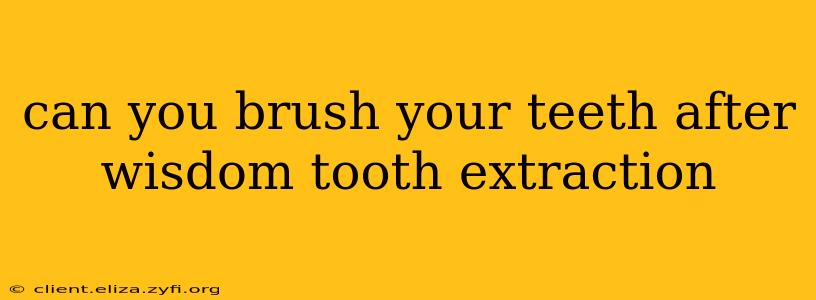Can You Brush Your Teeth After Wisdom Tooth Extraction?
The short answer is: yes, but carefully. Brushing your teeth after wisdom tooth extraction is crucial for maintaining oral hygiene and preventing infection, but you need to approach it with caution and the right technique to avoid disturbing the extraction site. The healing process is delicate, and improper brushing can dislodge blood clots, leading to a painful and potentially serious complication called dry socket.
Here's a detailed guide on how to brush your teeth after a wisdom tooth extraction, addressing common concerns:
How soon after wisdom tooth extraction can I brush my teeth?
Generally, you can begin gently brushing your teeth the day after your wisdom tooth extraction. However, avoid brushing directly over the extraction site for the first 24-48 hours. Your dentist or oral surgeon will give you specific post-operative instructions, so it's crucial to follow their advice. They may recommend waiting longer depending on the complexity of the extraction and your individual healing process.
How should I brush my teeth after wisdom tooth extraction?
- Gentle is key: Use a soft-bristled toothbrush and brush gently. Avoid vigorous scrubbing, especially near the extraction site.
- Focus on other areas: Concentrate your brushing on the areas of your mouth that are not directly affected by the extraction.
- Avoid the extraction site: For the first few days, completely avoid brushing directly over the extraction site. You can gently rinse the area with saltwater (see below).
- Angle your brush: When brushing near the extraction site (after the initial 24-48 hours), angle your toothbrush away from it to prevent irritation.
- Technique: Use short, gentle strokes, focusing on thorough cleaning rather than aggressive scrubbing.
What if I have pain when brushing?
If brushing causes significant pain, stop immediately and try rinsing with a saltwater solution. Contact your dentist or oral surgeon if the pain persists or worsens. Remember, pain is a signal that your body is trying to tell you something; don't ignore it.
What can I use instead of brushing near the extraction site?
In the initial days after extraction, you can rinse your mouth gently with saltwater. This helps to keep the area clean without disturbing the blood clot. Dissolve ½ teaspoon of salt in 8 ounces of warm water and gently swish it around your mouth, avoiding forceful rinsing near the extraction site.
What about using mouthwash after wisdom tooth extraction?
Avoid using alcohol-based mouthwashes for at least a week after the extraction, as they can irritate the extraction site. Your dentist might recommend a specific mouthwash to help with healing and prevent infection. Always follow their instructions.
What are the signs of a dry socket?
A dry socket is a painful condition that can occur when the blood clot at the extraction site dislodges. Signs include:
- Severe, throbbing pain that begins a few days after the extraction.
- Visible bone in the socket.
- Bad breath
- Persistent pain even with pain medication.
If you suspect a dry socket, contact your dentist or oral surgeon immediately. It requires prompt attention.
Remember, maintaining good oral hygiene after wisdom tooth extraction is crucial for a smooth recovery. By following these guidelines and paying close attention to your body's signals, you can minimize the risk of complications and ensure proper healing. Always consult with your dentist or oral surgeon for personalized post-operative care instructions. They are your best resource for specific guidance based on your individual circumstances.
